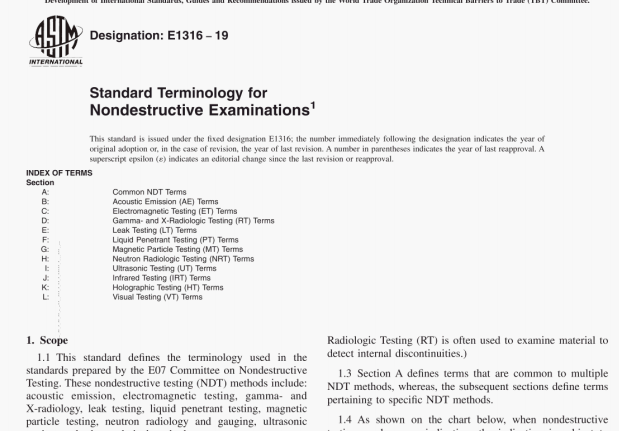ASTM E1316:2019 pdf download.Standard Terminology for Nondestructive Examinations.
coupling—two electric circuits are said to be coupled to each other when they have an impedance in common so that a current in one causes a voltage in the other.
cur-(fJ level—same as rejection level.
defect resolution—a property of an examination system that enables the separation of indications due to defects in a sample that are located in proximity to each other.
depth of penetration—the depth at which the magnetic field strength or intensity of induced eddy currents has decreased to 37 % of its surface value. The depth of penetration depends upon the coil size, the frequency of the signal, and the conductivity and permeability of the material. It is related to the coil size at low frequencies and is equal to the skin depth at high frequencies. Related synonymous terms are standard depth of penetration and skin depth. (See also skin effect.)
diamagnetic material—a material whose relative permeability is less than unity.
DiscussioN—The intrinsic induction Bi is oppositely directed to the applied magnetizing force H.
differential coils—two or more coils electrically connected in series opposition such that any electric or magnetic condition, or both, that is not common to the areas of a specimen being electromagnetically examined will produce an unbalance in the system and thereby yield an indication.
differential measurements—measurements made in which the imbalance in the system is measured using differential coils in contrast to absolute and comparative measurements. (See also differential coils.)
differential readout—the signal output of differential coils. (See also diflrential coils.)
differential signal—an output signal that is proportional to the rate of change of the input signal.
differential system—an electromagnetic examination system that uses coil assemblies and associated electronics to detect an electric or magnetic condition, or both, that is not common to the areas of the specimen being examined. (See also differential coils.)
eddy current—an electrical current caused to flow in a conductor by the time or space variation, or both, of an applied magnetic field.
eddy current testing—a nondestructive testing method in which eddy current flow is induced in the material under examination.
DiscussioN—Changes in the flow caused by variations in the specimen are reflected into a nearby coil, coils, Hall effect device, magnetoresistive sensor or other magnetic field sensor for subsequent analysis by suitable instrumentation and techniques.
edge effect—the disturbance of the magnetic field and eddy-
—currents due to the proximity of an abrupt change in specimen geometry (edge).
ASTM E1316:19 pdf download
